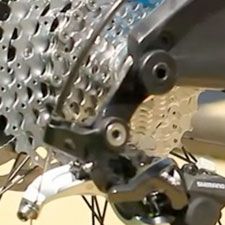IRVINE, CA (BRAIN) Thursday May 10 2012 10:23 AM MT—Shimano's 2013 Direct Mount rear derailleur option won't hit retail sales floors until early this fall, but the company already is responding to criticism from consumers who are concerned about a design offering an alternative to a standard dating to about 1953.
The DRD positions the rear derailleur mounting bolt 2 centimeters behind the axle, instead of almost directly below the axle. Essentially, it eliminates the B Link pivot from Shimano's Shadow derailleurs; the B Link created a secondary pivot point at the same location as the DRD attachment. 2013 Shadow derailleurs make the B Link a removable knuckle - the knuckle can be left on to mount on a normal hanger, or it can be removed to mount to a DRD hanger.
Eliminating the B Link should reduce weight and potential slop in the system. But a key advantage of the DRD is apparent when installing or removing wheels with 142x12 rear thru axles. The DRD also allows the use of shorter chainstays and is potentially stronger and stiffer than current designs, depending on exactly how frame manufacturers execute the design. It also could allow manufacturers to put more material around the rear dropout area to stiffen that part of the frame.
 Shimano spokesmen are quick to say that its DRD hanger specifications are optional. And many manufacturers who adopt the new standard will likely also make optional standard hangers available, for use with SRAM derailleurs or older Shimano derailleurs.
Shimano spokesmen are quick to say that its DRD hanger specifications are optional. And many manufacturers who adopt the new standard will likely also make optional standard hangers available, for use with SRAM derailleurs or older Shimano derailleurs.
Despite largely favorable reactions from journalists, consumers' comments on pinkbike.com, bikerumor.com and other websites were mostly dubious of the DRD.
"Never once have i thought i needed a 'more rigid platform for shifting'," one PinkBike commenter wrote. "Another prime example of bike industries fixing things that are not broke and finding ways to con people."
Similar comments frustrated Shimano's Joe Lawwill, especially since most of the consumers' concerns are answered in the articles above the comments. That's one reason he decided to make a video about the DRD.
"I shouldn't hang my hat on comments made online," said Lawwill. Nevertheless, he said, since it appeared the commenters were typing before they read the articles, "I thought maybe if I can get [the commenters] to sit through a video it would help," he said.
At the Sea Otter Classic last month, Shimano enlisted spokesmen from framebuilders including Ibis, Rocky Mountain, Yeti Cycles, GT Bicycles and Santa Cruz to appear in the video. The company posted the flick on YouTube and emailed a link to the media last week. In a cover letter with the video, Lawwill asked journalists to emphasize that the new standard is optional.
"There seems to be a lot of misunderstanding about the new direct mount standard, so if there is one thing I ask of all of you is that you make it clear whenever talking about DRD that you always mention it is an 'optional' rear derailleur mount," he wrote.
Whether the new option becomes a new standard remains to be seen. Today's hanger mount design dates to the 1950s, when Campagnolo standardized derailleur attachments on road bikes. Currently it appears that none of the Big Three suppliers in the U.S. — Trek, Specialized and Giant — are jumping on the DRD bandwagon for the upcoming model year.
The folks at Wheels Manufacturing are watching closely to see if the DRD takes off. The company manufactures scores of replaceable hanger designs for various brands and models of frames. The company's Dave Whittingham said that if DRD becomes popular, he hopes the industry will adopt a standard method of attachment to the frame, so one replacement hanger would fit all frames on the market.
"I'm not holding my breath for that," Whittingham said.


